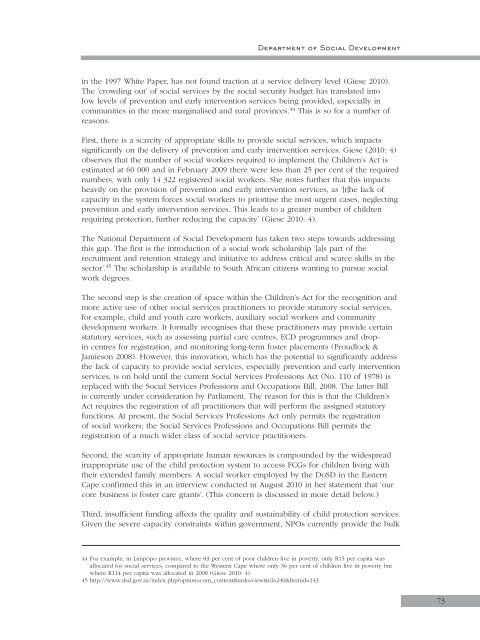Government-funded programmes and services for vulnerable - Unicef
Government-funded programmes and services for vulnerable - Unicef
Government-funded programmes and services for vulnerable - Unicef
Create successful ePaper yourself
Turn your PDF publications into a flip-book with our unique Google optimized e-Paper software.
Department of Social Development<br />
in the 1997 White Paper, has not found traction at a service delivery level (Giese 2010).<br />
The ‘crowding out’ of social <strong>services</strong> by the social security budget has translated into<br />
low levels of prevention <strong>and</strong> early intervention <strong>services</strong> being provided, especially in<br />
communities in the more marginalised <strong>and</strong> rural provinces. 44 This is so <strong>for</strong> a number of<br />
reasons.<br />
First, there is a scarcity of appropriate skills to provide social <strong>services</strong>, which impacts<br />
significantly on the delivery of prevention <strong>and</strong> early intervention <strong>services</strong>. Giese (2010: 4)<br />
observes that the number of social workers required to implement the Children’s Act is<br />
estimated at 60 000 <strong>and</strong> in February 2009 there were less than 25 per cent of the required<br />
numbers, with only 14 322 registered social workers. She notes further that this impacts<br />
heavily on the provision of prevention <strong>and</strong> early intervention <strong>services</strong>, as ‘[t]he lack of<br />
capacity in the system <strong>for</strong>ces social workers to prioritise the most urgent cases, neglecting<br />
prevention <strong>and</strong> early intervention <strong>services</strong>. This leads to a greater number of children<br />
requiring protection, further reducing the capacity’ (Giese 2010: 4).<br />
The National Department of Social Development has taken two steps towards addressing<br />
this gap. The first is the introduction of a social work scholarship ‘[a]s part of the<br />
recruitment <strong>and</strong> retention strategy <strong>and</strong> initiative to address critical <strong>and</strong> scarce skills in the<br />
sector’. 45 The scholarship is available to South African citizens wanting to pursue social<br />
work degrees.<br />
The second step is the creation of space within the Children’s Act <strong>for</strong> the recognition <strong>and</strong><br />
more active use of other social <strong>services</strong> practitioners to provide statutory social <strong>services</strong>,<br />
<strong>for</strong> example, child <strong>and</strong> youth care workers, auxiliary social workers <strong>and</strong> community<br />
development workers. It <strong>for</strong>mally recognises that these practitioners may provide certain<br />
statutory <strong>services</strong>, such as assessing partial care centres, ECD <strong>programmes</strong> <strong>and</strong> dropin<br />
centres <strong>for</strong> registration, <strong>and</strong> monitoring long-term foster placements (Proudlock &<br />
Jamieson 2008). However, this innovation, which has the potential to significantly address<br />
the lack of capacity to provide social <strong>services</strong>, especially prevention <strong>and</strong> early intervention<br />
<strong>services</strong>, is on hold until the current Social Services Professions Act (No. 110 of 1978) is<br />
replaced with the Social Services Professions <strong>and</strong> Occupations Bill, 2008. The latter Bill<br />
is currently under consideration by Parliament. The reason <strong>for</strong> this is that the Children’s<br />
Act requires the registration of all practitioners that will per<strong>for</strong>m the assigned statutory<br />
functions. At present, the Social Services Professions Act only permits the registration<br />
of social workers; the Social Services Professions <strong>and</strong> Occupations Bill permits the<br />
registration of a much wider class of social service practitioners.<br />
Second, the scarcity of appropriate human resources is compounded by the widespread<br />
inappropriate use of the child protection system to access FCGs <strong>for</strong> children living with<br />
their extended family members. A social worker employed by the DoSD in the Eastern<br />
Cape confirmed this in an interview conducted in August 2010 in her statement that ‘our<br />
core business is foster care grants’. (This concern is discussed in more detail below.)<br />
Third, insufficient funding affects the quality <strong>and</strong> sustainability of child protection <strong>services</strong>.<br />
Given the severe capacity constraints within government, NPOs currently provide the bulk<br />
44 For example, in Limpopo province, where 83 per cent of poor children live in poverty, only R15 per capita was<br />
allocated <strong>for</strong> social <strong>services</strong>, compared to the Western Cape where only 36 per cent of children live in poverty but<br />
where R114 per capita was allocated in 2008 (Giese 2010: 4).<br />
45 http://www.dsd.gov.za/index.php?option=com_content&task=view&id=240&Itemid=143<br />
73
















